Difference between revisions of "Preservation by drying, salting or freezing"
| Line 4: | Line 4: | ||
| − | If a fresh animal skin cannot be [[leather production|processed]] immediately in the [[tannery]], it is stored and preserved in order to | + | If a fresh animal skin cannot be [[leather production|processed]] immediately in the [[tannery]], it is stored and preserved in order to halt decay. This must be done quickly to prevent bacterial growth, which usually begins approximately 2 hours after slaughter. Bacteria can destroy the skin (putrefaction) and render it unusable for making [[Fur - Fur skin|fur]] or [[leather]]. The optimal temperature for storing the skins is between 4 - 7 ° C. Hanging them to drain the blood is also important. |
Common methods of preservation are freezing, salting and drying. | Common methods of preservation are freezing, salting and drying. | ||
| Line 10: | Line 10: | ||
== Freezing - cooling == | == Freezing - cooling == | ||
| − | Freezing is the most straightforward method. Fresh skins are packed in plastic and stored in cooling rooms. Apart from the energy costs of cooling, this method has a lot of advantages. Freezing stops the | + | Freezing is the most straightforward method. Fresh skins are packed in plastic and stored in cooling rooms. Apart from the energy costs of cooling, this method has a lot of advantages. Freezing stops the decomposition process immediately, the shelf life of the stored raw material is unlimited and, if required, the skins can be processed immediately - as if they were coming in straight from the slaughterhouse. |
| Line 22: | Line 22: | ||
==Salting== | ==Salting== | ||
| − | The | + | The salting preservation method primarily drains the skin. It is essential that the salt (chemical: sodium chloride) is fresh. A salt which has already been used for preservation contains too many microorganisms and therefore does not guarantee good preservation when reused. The salt should not contain impurities, due to iron compounds. Likewise, only very small amounts of calcium or magnesium compounds may be present as impurities. |
| − | The method of salting is free | + | The method of salting is free from cooling, but must be carried out very conscientiously in order to avoid putrefaction of the skin. Sufficient salt is required to completely saturate the skin so as to stop any bacterial growth. For this reason, the [[rawhide]] has to be salted with 40 - 50% salt in relation to the skin weight. This equates to more than one centimetre layer of salt on the [[flesh side]] of the skin. Therefore, a skin with 40 - 50 kg requires approximately 20 - 25 kg of salt. |
The process involves sprinkling the skin with solid salt (dry salting) or by treating the skin with salt solutions (wet salting). | The process involves sprinkling the skin with solid salt (dry salting) or by treating the skin with salt solutions (wet salting). | ||
| Line 51: | Line 51: | ||
==Drying== | ==Drying== | ||
| − | The simplest and oldest preservation process is drying. The skin is thus stretched in the dry air in such a way that air can flow around the hide from all sides. The moisture required for the development of microorganisms is thereby removed from the skins. The skins should dry quickly, but | + | The simplest and oldest preservation process is drying. The skin is thus stretched in the dry air in such a way that air can flow around the hide from all sides. The moisture required for the development of microorganisms is thereby removed from the skins. The skins should dry quickly, but never at too high temperatures (not above 30 ° C) and never in direct sunlight or next to a radiator, since this leads to [[Shrunken leather - leather shrinkage|irreversible damage]] of the skin collagen! Dried leathers are hard. |
The skin must not be exposed to moisture during drying (e.g. by sudden rain). Otherwise, the decomposition process is initiated, the skin starts to rot, and insects are being lured. | The skin must not be exposed to moisture during drying (e.g. by sudden rain). Otherwise, the decomposition process is initiated, the skin starts to rot, and insects are being lured. | ||
| Line 72: | Line 72: | ||
== [[Leather videos|Video]] about [[leather production]]== | == [[Leather videos|Video]] about [[leather production]]== | ||
<p align=center> | <p align=center> | ||
| − | <flashow> | + | <flashow>//www.youtube.com/v/zbj1QicTdpI&fs=1&color1=0x660000&color2=0x550000&border=1|width=500|height=281,25</flashow><br></p> |
<p align=center> | <p align=center> | ||
''The [[leather production]] in a modern [[tannery]].'' | ''The [[leather production]] in a modern [[tannery]].'' | ||
| Line 82: | Line 82: | ||
! bgcolor=#eeeeee | [[Leather production|Process steps in the leather production]] | ! bgcolor=#eeeeee | [[Leather production|Process steps in the leather production]] | ||
|- | |- | ||
| − | | bgcolor=#ffffff align=center | [[storage of leather| | + | | bgcolor=#ffffff align=center | [[storage of leather|Storage]] - [[soaking]] - [[Liming - Leather Tanning|liming]] - [[Fleshing - Making of leather|fleshing]] - [[Split leather|splitting]] - [[pickling]] - [[Tanning leather|tanning]] - [[neutralising]] - [[Drying leather|withering]] - [[Leather production#Sorting|sorting]] - [[shaving]] - [[Leather production#Dyeing (through colouring) and fatliquoring|dyeing (through colouring) and fatliquoring]] - [[Drying leather|drying]] - [[finish]] - [[softening]] - [[Leather quality|final check]] |
|} | |} | ||
</center> | </center> | ||
Revision as of 11:36, 24 March 2017
If a fresh animal skin cannot be processed immediately in the tannery, it is stored and preserved in order to halt decay. This must be done quickly to prevent bacterial growth, which usually begins approximately 2 hours after slaughter. Bacteria can destroy the skin (putrefaction) and render it unusable for making fur or leather. The optimal temperature for storing the skins is between 4 - 7 ° C. Hanging them to drain the blood is also important.
Common methods of preservation are freezing, salting and drying.
Contents
Freezing - cooling
Freezing is the most straightforward method. Fresh skins are packed in plastic and stored in cooling rooms. Apart from the energy costs of cooling, this method has a lot of advantages. Freezing stops the decomposition process immediately, the shelf life of the stored raw material is unlimited and, if required, the skins can be processed immediately - as if they were coming in straight from the slaughterhouse.
Cooled Rawhide.
Salting
The salting preservation method primarily drains the skin. It is essential that the salt (chemical: sodium chloride) is fresh. A salt which has already been used for preservation contains too many microorganisms and therefore does not guarantee good preservation when reused. The salt should not contain impurities, due to iron compounds. Likewise, only very small amounts of calcium or magnesium compounds may be present as impurities.
The method of salting is free from cooling, but must be carried out very conscientiously in order to avoid putrefaction of the skin. Sufficient salt is required to completely saturate the skin so as to stop any bacterial growth. For this reason, the rawhide has to be salted with 40 - 50% salt in relation to the skin weight. This equates to more than one centimetre layer of salt on the flesh side of the skin. Therefore, a skin with 40 - 50 kg requires approximately 20 - 25 kg of salt.
The process involves sprinkling the skin with solid salt (dry salting) or by treating the skin with salt solutions (wet salting).
Salted hides can be kept for several months and are resistant to temperature fluctuations. However, they must be stored in a certain manner after drying. Skin areas cannot touch or lie on each other. Salted skins are a favourite food for mice and rats. The hides should not be kept in a humid environment as they soon become a breeding ground for insects which lay their eggs on them.
The seeding process can be carried out by hand or by using a machine.
Salted rawhide in the tannery.
Drying
The simplest and oldest preservation process is drying. The skin is thus stretched in the dry air in such a way that air can flow around the hide from all sides. The moisture required for the development of microorganisms is thereby removed from the skins. The skins should dry quickly, but never at too high temperatures (not above 30 ° C) and never in direct sunlight or next to a radiator, since this leads to irreversible damage of the skin collagen! Dried leathers are hard.
The skin must not be exposed to moisture during drying (e.g. by sudden rain). Otherwise, the decomposition process is initiated, the skin starts to rot, and insects are being lured.
Dried stingray leather.
Additional information
Video about leather production
The leather production in a modern tannery.
| Tanning methods |
|---|
| Chrome tanning - Vegetable-tanned leather - Synthetic tanning - Tanning with fats and oils |







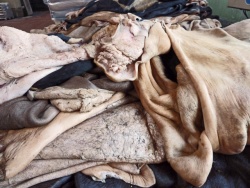
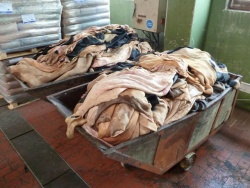
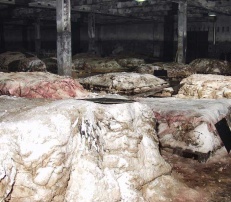
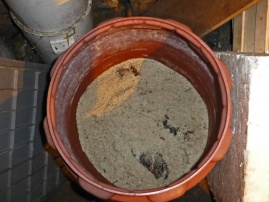
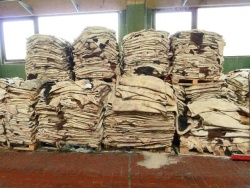
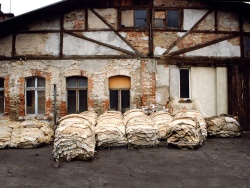
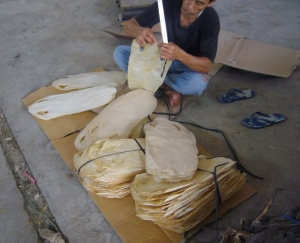

 a kotori web solution
a kotori web solution